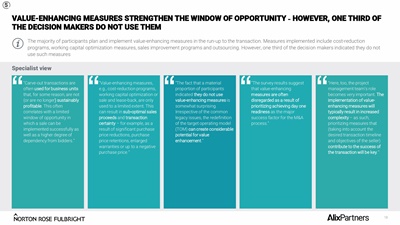
18
Specialist view
VALUE-ENHANCING MEASURES STRENGTHEN THE WINDOW OF OPPORTUNITY ˗ HOWEVER, ONE THIRD OF
THE DECISION MAKERS DO NOT USE THEM
The majority of participants plan and implement value-enhancing measures in the run-up to the transaction. Measures implemented include cost-reduction
programs, working capital optimization measures, sales improvement programs and outsourcing. However, one third of the decision makers indicated they do not
use such measures
"Carve-out transactions are
often used for business units
that, for some reason, are not
(or are no longer) sustainably
profitable. This often
correlates with a limited
window of opportunity in
which a sale can be
implemented successfully as
well as a higher degree of
dependency from bidders."
"The fact that a material
proportion of participants
indicated they do not use
value-enhancing measures is
somewhat surprising.
Irrespective of the common
legacy issues, the redefinition
of the target operating model
(TOM) can create considerable
potential for value
enhancement."
"Here, too, the project
management team's role
becomes very important. The
implementation of valueenhancing
measures will
typically result in increased
complexity - as such,
prioritizing measures that
(taking into account the
desired transaction timeline
and objectives of the seller)
contribute to the success of
the transaction will be key."
"The survey results suggest
that value-enhancing
measures are often
disregarded as a result of
prioritizing achieving day one
readiness as the major
success factor for the M&A
process."
"Value-enhancing measures,
e.g., cost-reduction programs,
working capital optimization or
sale and lease-back, are only
used to a limited extent. This
can result in sub-optimal sales
proceeds and transaction
certainty - for example, as a
result of significant purchase
price reductions, purchase
price retentions, enlarged
warranties or up to a negative
purchase price."
5